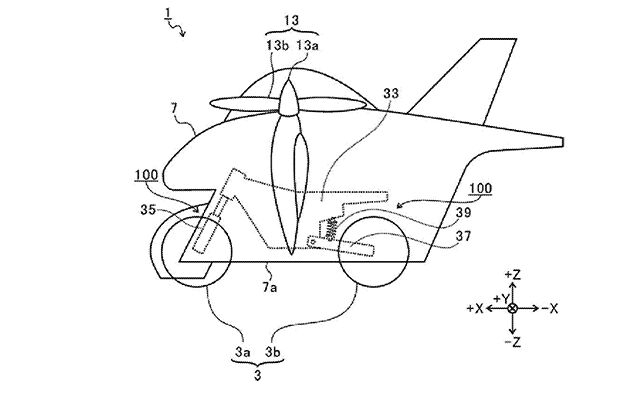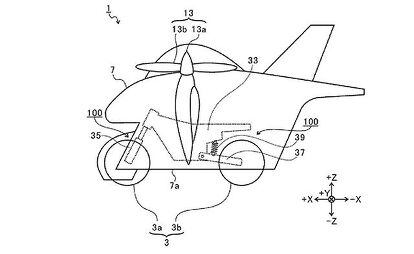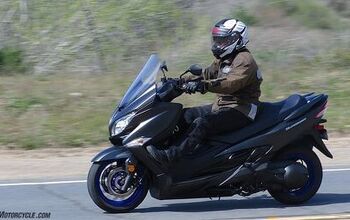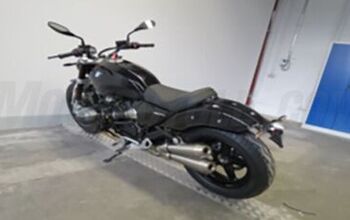It's No Joke: Subaru is Developing a Flying Motorcycle

Yes, we are aware what day it is
Japanese automaker Subaru has filed patent applications for a flying motorcycle. The patents describe a land-and-air vehicle that is essentially a motorcycle enclosed within an aircraft fuselage with vertical takeoff and landing (VTOL) capabilities.
Before we get any further: yes, we are aware that today is April 1, and chances are, nobody reading this will believe us. But it’s all true. The U.S. Patent and Trademark Office published it on April Fool’s Day, but Subaru’s patent application was originally filed with the agency on July 22, 2020, following an original patent filed in Japan on Sept. 30, 2019. The April 1 publication date is completely incidental. If that’s not convincing enough, this is actually the second patent application Subaru has filed for a flying motorcycle. The previous application was published by the USPTO on March 4, after being filed May 13, 2020 with an original filing in Japan on Aug. 28, 2019. So, no, despite how outrageous it may sound, it’s very true: Subaru is developing a flying motorcycle.
Both patents describe a similar vehicle, one that can travel on the ground like a motorcycle and, when required, can lift off the ground and fly like an aircraft. The whole thing still sounds like complete science fiction, but a company like Subaru actually has the expertise to turn it into reality. While most people think of it as a car company, Subaru is also heavily involved in the aerospace industry, producing helicopters and unmanned aerial vehicles for the Japanese Self Defense Force while also producing parts for Boeing’s 777X airliner.
The more recent of the two patent applications describes how the vehicle converts between air and land modes. As a ground vehicle, the wings are folded up along the side of the fuselage as in Fig. 1 above. For vertical takeoffs and landings, the wings are deployed to either side with the rotors pointed up. The two wing propellers and the rotor fixed to the tail provide lift to get the vehicle off the ground. The wings can then tilt forward until they are horizontal like a conventional airplane.
While it describes how the wings work, the patent application is mainly concerned with a method to retract the two wheels. Instead of traditional aircraft landing gear, the vehicle’s wheels are like a conventional motorcycle: the front wheel is connected to the frame while the rear wheel is attached via a swingarm, with each wheel having its own suspension system. In flight mode, a locking mechanism compresses the suspension systems, retracting the wheels into the fuselage.
On the ground, the vehicle uses an internal combustion engine to rotate the drive wheel. The crankshaft is also coupled to an electric generator which charges a battery that powers the electric motors in the propellers.
The patent from March describes how the vehicle is controlled, both in the air and on the ground. The ground controls in particular should be easily recognizable for any motorcyclist. A handlebar steers the front wheel with hand controls for the throttle, front brake, and clutch. The rear brake lever is in front of the right foot peg while a shift lever is in front of the left peg. As the patent application explains: “This makes it possible to operate the land-and-air vehicle in the same way as in operating an ordinary motorcycle.”
What is unique is the addition of two levers (17 and 18) at either end of the handlebar. The right lever (17) controls the speed of the propellers. Tilting the lever up (in the α direction) increases the propeller speed while tilting it forward (β) slows them. Note that the direction of rotation for increasing or decreasing the propeller throttle is the same as for the motorcycle throttle grip.
The left handlebar also has a lever (18) that controls the vehicle’s pitch while in the air. Pulling it back lifts the nose up while pushing it forward points the nose down. In flight mode, a steer-by-wire system translates turning the handlebar left or right into an appropriate yaw and roll motion to turn the aircraft.
The foot controls also play a role in flight mode. The shift lever adjusts the angle of the wings which, in turn, adjusts the level of thrust. Pointing the wings and propeller forward maximizes thrust but tilting them upward reduces flight speed. In a sense, the vehicle treats the wing’s tilt angle as a motorcyclist would gears in a transmission. The footpegs themselves control the aircraft’s roll. Sensors in the pegs measure the operator’s foot pressure, electronically translating the data and adjusts the aircraft’s ailerons to make it roll. Putting more pressure on one peg makes the aircraft lean in that direction, just as weighting the pegs can help a motorcycle lean into corners.
Altogether, it sounds like Subaru’s put a lot of work into developing this flying motorcycle, even going so far as to make the flight controls mirror the a motorcycle’s controls in many ways. In addition to the manual flight controls, the patent describes an autopilot mode as well as an assisted operation mode which handles pitching and rolling, leaving the pilot to focus on simple turns, ascent or descent and flying speed.
Of course, none of this would suggest that we’re any closer to seeing a Subaru flying motorcycle in action. April 1st or not (again, we reiterate, these patent applications are real and not a prank), we have a hard time believing flying bikes will become a reality any time soon. We do, however, encourage Subaru to prove us wrong.
Become a Motorcycle.com insider. Get the latest motorcycle news first by subscribing to our newsletter here.

Dennis has been a part of the Motorcycle.com team since 2008, and through his tenure, has developed a firm grasp of industry trends, and a solid sense of what's to come. A bloodhound when it comes to tracking information on new motorcycles, if there's a new model on the horizon, you'll probably hear about it from him first.
More by Dennis Chung












































Comments
Join the conversation
A) I want one. B) How do you throw a leg over it in ground mode?
They're going to need a test ri....pilot.
Subaru, if you're listening, I can be contacted at Rolling Physics Problem. ;-)